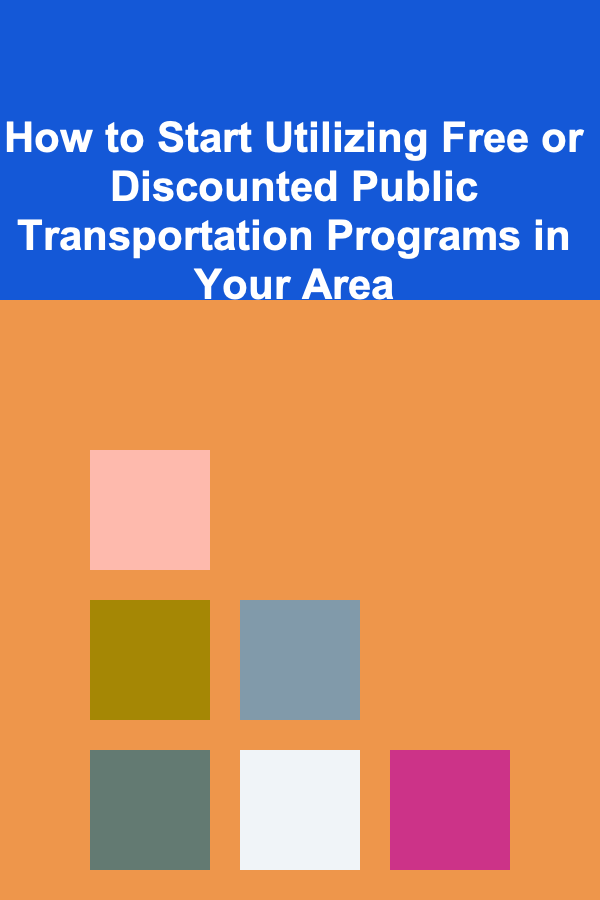
How to Start Utilizing Free or Discounted Public Transportation Programs in Your Area
ebook include PDF & Audio bundle (Micro Guide)
$12.99$5.99
Limited Time Offer! Order within the next:

Public transportation is an essential part of many communities, offering a convenient and cost-effective way to get around. However, for many people, the cost of regular transportation can be a significant burden. Fortunately, many cities and regions offer free or discounted public transportation programs that can help reduce transportation expenses and promote sustainability. These programs are designed to make public transit more accessible to a wide range of people, from students to seniors, low-income individuals, and those with disabilities.
In this actionable guide, we'll explore how to start utilizing these programs, helping you save money while contributing to a greener, more sustainable community.
Research Local Public Transportation Programs
The first step in utilizing free or discounted public transportation programs is to research what's available in your area. Different cities and regions have different initiatives, and understanding your options is essential for making the most of these programs.
Where to Start:
- City Websites: Many local transportation agencies list available programs and discounts on their websites. Look for sections dedicated to "discounted fares," "free rides," or "special programs."
- Transit Apps: Some cities have mobile apps that provide real-time updates and information on transportation programs. These apps may include details on eligibility requirements, routes, and costs associated with discounted services.
- Social Media and News: Local government social media accounts or neighborhood community groups may share updates on newly launched programs or temporary discounts.
- Public Libraries and Community Centers: Local public resources like libraries and community centers can also be great places to find information on discounted or free transportation options in your area.
Types of Programs to Look For:
- Free Rides for Seniors and Disabled Individuals: Many regions offer free or heavily discounted public transportation for seniors and those with disabilities.
- Low-Income Programs: Some areas have income-based fare structures that allow low-income individuals to access discounted or free transit services.
- Student Discounts: Many universities, colleges, and schools partner with transit authorities to offer students discounted or free rides.
- Promotional Free Rides: Certain cities offer free rides during special events, holidays, or specific times of the year to encourage the use of public transportation and reduce traffic congestion.
- Employer-Sponsored Transportation: Some employers partner with public transportation agencies to provide free or discounted passes for their employees.
Check Eligibility Requirements
Once you've identified the relevant programs in your area, the next step is to check if you are eligible for any of them. Most free or discounted programs have specific eligibility requirements, and it's important to ensure that you meet those requirements before you can start utilizing the benefits.
Common Eligibility Criteria:
- Age: Many programs offer discounts for children, students, or seniors. You may need to provide proof of age when applying for a discount or free ride pass.
- Income: For low-income discount programs, you may need to provide proof of income, such as tax returns, pay stubs, or government assistance documentation, to qualify for the program.
- Disability Status: If you have a disability, you may qualify for reduced or free fares. You may need to provide documentation of your disability from a healthcare provider.
- Student Enrollment: If a program offers discounted fares for students, you'll likely need to show proof of enrollment in an educational institution.
Action Steps:
- Review Documentation Requirements: Make sure you have all the necessary paperwork or identification required to apply for discounts or free transit passes.
- Understand the Application Process: Some programs may require you to apply online, while others may have in-person registration. Take note of deadlines or periods when discounts are offered.
- Consult Your Local Transportation Authority: If you're unsure about eligibility, you can always call or visit your local transit office to get guidance.
Apply for the Discount or Free Transit Pass
After confirming your eligibility, the next step is to apply for the free or discounted transit pass. This can often be done online, at local government offices, or through community centers. The process varies depending on the program, but here are some common steps to follow.
How to Apply:
- Online Applications: Many public transportation agencies allow you to apply for discounts or passes through their website. You will need to create an account and submit the required documentation.
- In-Person Application: Some programs may require you to visit a local office to submit paperwork in person. Be sure to bring all necessary documents, such as identification, proof of eligibility, and any required forms.
- Transit Agency or Mobile App: If the transportation program is managed through a mobile app, you may be able to apply directly within the app by uploading your documents and selecting your fare options.
Important Tips:
- Start Early: Processing times can vary, so be sure to apply early to avoid delays, especially if you need the pass for an upcoming trip or event.
- Keep Track of Expiration Dates: Many free or discounted passes have expiration dates or require annual renewal. Mark your calendar to ensure you stay on top of renewals.
- Look for Additional Benefits: Some programs may offer additional benefits, such as access to special routes or priority seating. Make sure to ask about these extras when applying.
Use Your Transit Pass and Explore Transit Options
Once you've received your discounted or free transit pass, it's time to start using it! Take advantage of the cost savings and explore the different transportation options available to you.
Make the Most of Your Pass:
- Plan Your Routes: Use the transit agency's website or app to plan your routes in advance. Many transit apps offer real-time information on bus or train schedules, delays, and route maps.
- Combine Transportation Options: Many cities offer multiple modes of public transportation, such as buses, trains, and ferries. You can combine these options to create the most efficient and cost-effective travel plan.
- Look for Additional Perks: Some discounted passes may offer added perks, such as free transfers between bus and train lines, or access to special express routes. Be sure to familiarize yourself with all the benefits your pass provides.
Sustainable Transportation Choices:
- Eco-Friendly Benefits: Public transportation is not only a more affordable option, but it's also environmentally friendly. By choosing public transit, you help reduce traffic congestion, lower your carbon footprint, and promote a more sustainable way of traveling.
Spread the Word About Available Programs
One of the best ways to make the most of free or discounted transportation programs is to share the information with others in your community. Many people may not be aware of the options available to them, and by spreading the word, you can help others benefit from these resources as well.
Ways to Share Information:
- Social Media: Share program details and eligibility requirements on social media platforms to reach a wide audience.
- Community Meetings or Events: If you're involved in community groups, consider hosting a meeting or distributing flyers with information on local transportation programs.
- Encourage Local Businesses: If you're part of a business or organization, encourage them to share information about transportation discounts with employees, clients, or customers.
Advocate for More Programs in Your Area
If you find that there are few or no free or discounted transportation programs in your area, consider advocating for the introduction of these initiatives. Many cities and regions are actively looking for ways to reduce traffic congestion, increase access to public transit, and support sustainable transportation.
How to Advocate:
- Reach Out to Local Government: Contact your city council or local transit authorities to express your interest in discounted or free public transportation programs.
- Start Petitions: If you believe there is significant community interest, consider starting a petition or gathering support to encourage local policymakers to consider implementing new transportation programs.
- Collaborate with Community Groups: Partner with local advocacy groups, schools, or businesses to build momentum and support for new transportation programs.
Conclusion
Utilizing free or discounted public transportation programs is a smart way to save money, reduce your carbon footprint, and improve your community's accessibility to transportation. By doing your research, understanding eligibility requirements, and taking full advantage of these opportunities, you can enjoy the many benefits public transportation offers while contributing to a more sustainable future. Whether you're a student, senior, or low-income individual, there are likely options available to you---so start exploring today!
Reading More From Our Other Websites
- [Home Pet Care 101] How to Maintain Your Pet's Toys and Accessories
- [Organization Tip 101] Smart Faucets vs. Traditional Faucets: Which One Is Right for You?
- [Home Party Planning 101] How to Create a Relaxing Atmosphere for a Dinner Party
- [Home Staging 101] How to Stage Your Home for Luxury Buyers
- [Home Maintenance 101] How to Clean and Maintain Your Garbage Disposal
- [Home Budget Decorating 101] How to Style Your Bookshelves Affordably
- [Home Security 101] How to Decide Between DIY and Professional Home Security Installation
- [Home Budget 101] How to Save for a Down Payment on a New Home
- [Personal Care Tips 101] How to Choose Hair Gel for Soft, Touchable Styles
- [Personal Care Tips 101] How to Apply Mascara for an Elegant Evening Look

How to Create a Weekly Cleaning and Maintenance Schedule
Read More
How to Use Drawer Organizers to Maximize Kitchen Space
Read More
How to Utilize Old Shoe Boxes for Craft and School Supply Storage
Read More
How To Build a Strong Foundation for Social Skills
Read More
How to Use CAD Software for Biomedical Device Design
Read More
10 Tips for Investing for Retirement in Your 20s
Read MoreOther Products

How to Create a Weekly Cleaning and Maintenance Schedule
Read More
How to Use Drawer Organizers to Maximize Kitchen Space
Read More
How to Utilize Old Shoe Boxes for Craft and School Supply Storage
Read More
How To Build a Strong Foundation for Social Skills
Read More
How to Use CAD Software for Biomedical Device Design
Read More